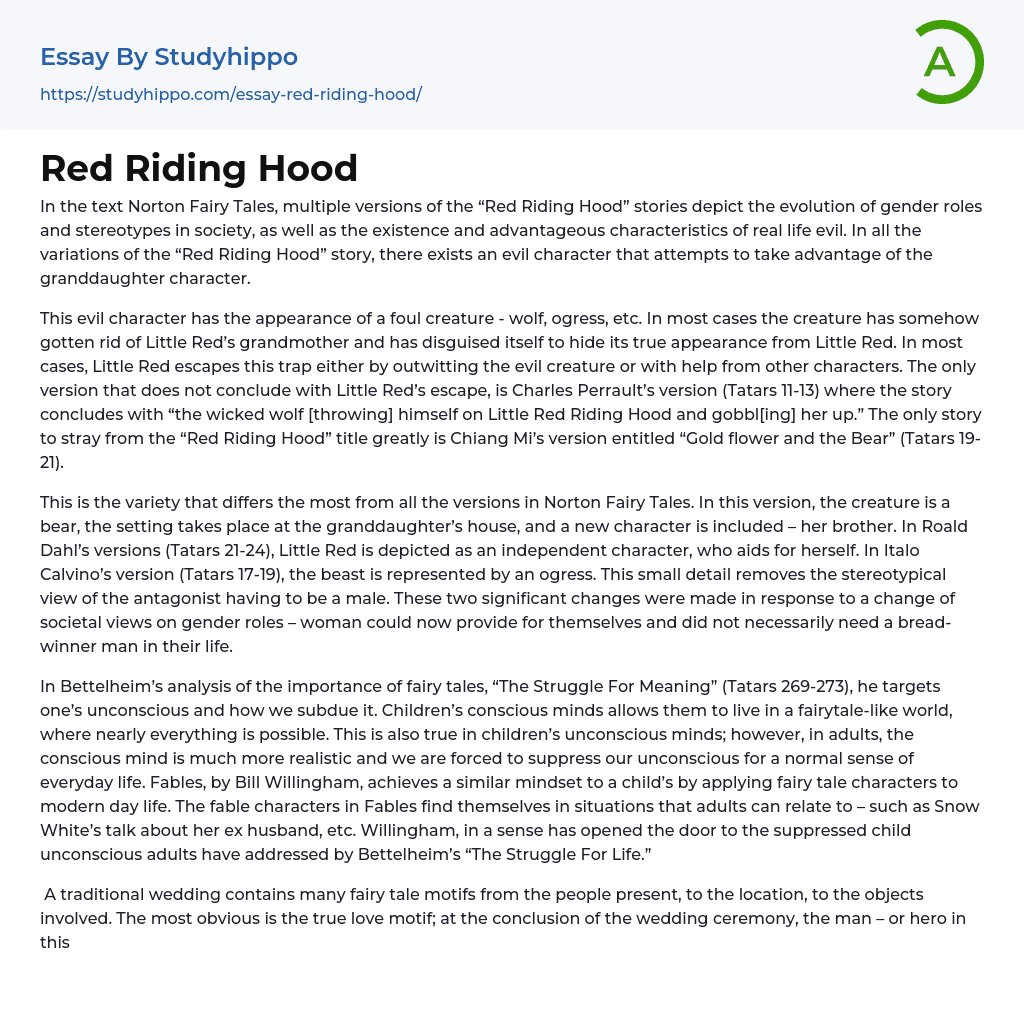In the text Norton Fairy Tales, multiple versions of the “Red Riding Hood” stories depict the evolution of gender roles and stereotypes in society, as well as the existence and advantageous characteristics of real life evil. In all the variations of the “Red Riding Hood” story, there exists an evil character that attempts to take advantage of the granddaughter character.
This evil character has the appearance of a foul creature - wolf, ogress, etc. In most cases the creature has somehow gotten rid of Little Red’s grandmother and has disguised itself to hide its true appearance from Little Red. In most cases, Little Red escapes this trap either by outwitting the evil creature or with help from other characters. The only version that does not conclude with Little Red’s escape, is Charles Perrault’
...s version (Tatars 11-13) where the story concludes with “the wicked wolf [throwing] himself on Little Red Riding Hood and gobbl[ing] her up.” The only story to stray from the “Red Riding Hood” title greatly is Chiang Mi’s version entitled “Gold flower and the Bear” (Tatars 19-21).
This is the variety that differs the most from all the versions in Norton Fairy Tales. In this version, the creature is a bear, the setting takes place at the granddaughter’s house, and a new character is included – her brother. In Roald Dahl’s versions (Tatars 21-24), Little Red is depicted as an independent character, who aids for herself. In Italo Calvino’s version (Tatars 17-19), the beast is represented by an ogress. This small detail removes the stereotypical view of the antagonist having to be a male. These two significant changes were
made in response to a change of societal views on gender roles – woman could now provide for themselves and did not necessarily need a bread-winner man in their life.
In Bettelheim’s analysis of the importance of fairy tales, “The Struggle For Meaning” (Tatars 269-273), he targets one’s unconscious and how we subdue it. Children’s conscious minds allows them to live in a fairytale-like world, where nearly everything is possible. This is also true in children’s unconscious minds; however, in adults, the conscious mind is much more realistic and we are forced to suppress our unconscious for a normal sense of everyday life. Fables, by Bill Willingham, achieves a similar mindset to a child’s by applying fairy tale characters to modern day life. The fable characters in Fables find themselves in situations that adults can relate to – such as Snow White’s talk about her ex husband, etc. Willingham, in a sense has opened the door to the suppressed child unconscious adults have addressed by Bettelheim’s “The Struggle For Life.”
A traditional wedding contains many fairy tale motifs from the people present, to the location, to the objects involved. The most obvious is the true love motif; at the conclusion of the wedding ceremony, the man – or hero in this sense – has completed his battle to win his true love, his bride. The presence of the bride’s father is also a key motif that translates over. The father is considered an elder, and thus is seen as wise, etc.
The main object motif in a wedding is the wedding band – the ring. In fairy tales, motifs that involve objects
are typically objects that hold a specific strength or magic power. The wedding band that is exchanged from groom to bride and bride to groom is symbolic of many things, but has the power and strength of holding the marriage together – which is why many adulterers remove their ring before committing an act against the ring, against the marriage.
Taylor Swift’s song “Love Story,” along with many others she has written, references the fairy motif of true love. The conclusion of the song ends with the happy ending of the protagonist’s true love arriving and saving her from her loneliness - “Romeo save me I've been feeling so alone…He knelt to the ground and pulled out a ring” (Swift). This is a common motif that repeats throughout many of Swift’s lyrics.
- Allegory essays
- Alliteration essays
- Comedy essays
- Comic book essays
- Drama essays
- Dystopia essays
- Fairy Tale essays
- Fantasy essays
- Fiction essays
- Ghost essays
- Gothic Fiction essays
- Gothic Literature essays
- Irony essays
- Legend essays
- Memoir essays
- Novel essays
- Poetry essays
- Satire essays
- Science Fiction essays
- Short Story essays
- The western essays
- Tragedy essays
- Witchcraft essays
- 1984 essays
- A Farewell to Arms essays
- A Good Man Is Hard to Find essays
- A Hanging essays
- A Lesson Before Dying essays
- A Long Way Gone essays
- A Rose For Emily essays
- A Separate Peace essays
- A Tale Of Two Cities essays
- A Very Old Man With Enormous Wings essays
- Adventures Of Huckleberry Finn essays
- Alice in Wonderland essays
- All Quiet on The Western Front essays
- Allegory of the Cave essays
- An occurrence at owl creek bridge essays
- Animal Farm essays
- Anthem essays
- Antigone essays
- Arthur Conan Doyle essays
- As I Lay Dying essays
- Atticus Finch essays
- Barn Burning essays
- Battle Royal essays
- Beauty and The Beast essays
- Beloved essays
- Boo Radley essays
- Brave New World essays




